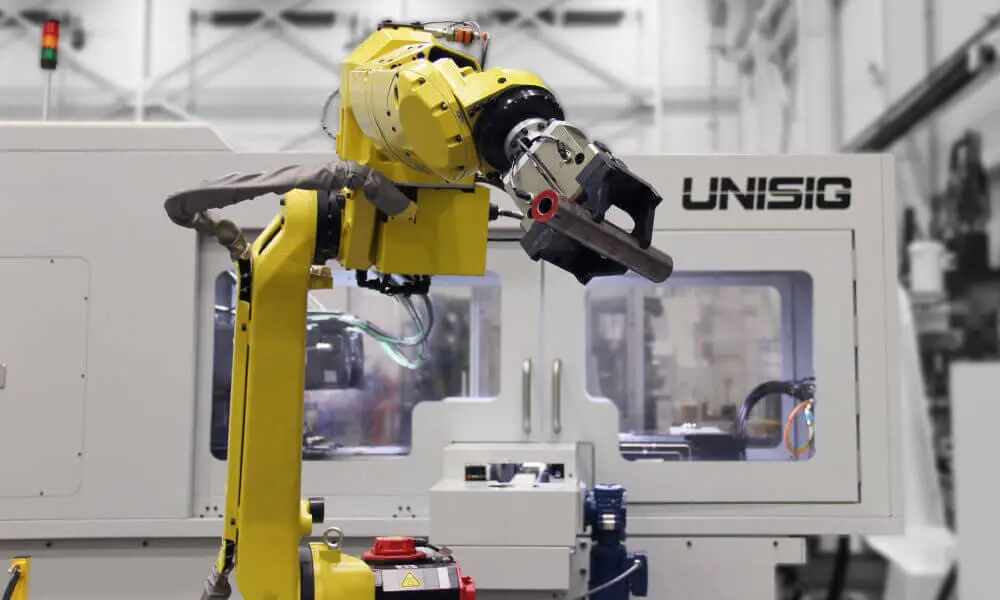UNISIG introduced a solution that would consolidate multiple gundrilling machines into a UNI25HD multi-spindle machine, replacing several decades-old pieces of equipment to free up floor space,

Modernized High Volume Receiver Production | Case Study
- Posted on
- Anthony Fettig
High powered gundrilling production is performed on the UNI25HD automated cell.
 Rifle barrel receivers go on every rifle that is manufactured, and a growing firearms industry has affected the demands of manufacturers. One US based firearms manufacturer saw their production pushed to the limits with their existing equipment, and recognized the opportunity to update their older gundrilling machines to match their modern manufacturing facility. Their goal was to modernize, to handle current and future demand, eliminate a manufacturing bottleneck, and maintain the highest efficiency and accuracy standards possible.
Rifle barrel receivers go on every rifle that is manufactured, and a growing firearms industry has affected the demands of manufacturers. One US based firearms manufacturer saw their production pushed to the limits with their existing equipment, and recognized the opportunity to update their older gundrilling machines to match their modern manufacturing facility. Their goal was to modernize, to handle current and future demand, eliminate a manufacturing bottleneck, and maintain the highest efficiency and accuracy standards possible.
UNISIG introduced a solution that would consolidate multiple gundrilling machines into a UNI25HD multi-spindle machine, replacing several decades-old pieces of equipment to free up floor space, and equipping the machine with high power and control technology that allows them to take advantage of newly updated tooling technology. By combining multiple spindles and high feed rates of these new indexable gundrills, receivers are now produced at a rate of more than 100 parts per hour, in a steady one piece flow, significantly improving their previous production rate.
 Indexable gundrills are rigid gundrilling tools that use replaceable carbide inserts and wear pads for holes from 0.53 -2.00 in [13.5 – 50 mm] in diameter, at extremely high feed rates, the optimal solution for receiver components in a high production environment. Typical feed rate increase is from 3-4 times faster with indexable gundrilling, yet they found themselves with an improvement of 4-6 times over their previous production.
Indexable gundrills are rigid gundrilling tools that use replaceable carbide inserts and wear pads for holes from 0.53 -2.00 in [13.5 – 50 mm] in diameter, at extremely high feed rates, the optimal solution for receiver components in a high production environment. Typical feed rate increase is from 3-4 times faster with indexable gundrilling, yet they found themselves with an improvement of 4-6 times over their previous production.
This deep hole drilling process is supported by UNISIG’s UNI25HD 4-spindle, heavy duty gundrilling machine. This machine provides additional power, torque, and thrust required for these high-feed gundrills, as well as having extra rigid components to handle any vibration produced as a result of extremely high feed rates. Each spindle on the UNI25HD provides 19 hp [14 kW] of power to the tool, and the machine also offers increased coolant capabilities to handle the rapid removal of chips, while keeping the process clean and enclosed.
Embedded automation is used to match the drastically improved production rate, and to integrate the gundrilling step with the cut-off lathe beforehand, and turning steps that follow.
 Infeed automation, as shown in the above video, load parts from the previous step onto the smart conveyor, where they are indexed to load a four-part cycle, and lifted into chucks for the approximate one minute drilling cycle. Robotic unloading on the outfeed side brings parts to the next manufacturing step, turning, at a pace that also matches gundrilling. Additional parts continue to load and unload, aligned with the drilling rate, in a steady one piece flow production and eliminating the previous bottleneck.
Infeed automation, as shown in the above video, load parts from the previous step onto the smart conveyor, where they are indexed to load a four-part cycle, and lifted into chucks for the approximate one minute drilling cycle. Robotic unloading on the outfeed side brings parts to the next manufacturing step, turning, at a pace that also matches gundrilling. Additional parts continue to load and unload, aligned with the drilling rate, in a steady one piece flow production and eliminating the previous bottleneck.
UNISIG’s technical team, along with tooling manufacturers, optimized the process and produced an automated system that was a clear solution for this customer. Their team was impressed with the clean, modern system that fit well into their modern manufacturing concept. UNISIG also provided installation and training to ensure they can hit their production and accuracy goals without issue.
The UNISIG UNI25HD machine ultimately eliminated the production bottleneck and floor space issues previously affecting manufacturing, and introduced a compact, high-value automated machine that maximizes production, allowing them to keep up with any demand they may face.

